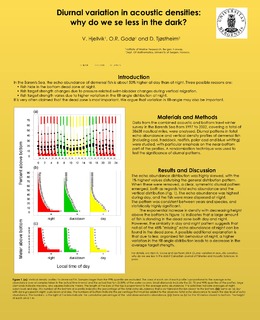Diurnal variation in acoustic densities: why do we se less in the dark?
Working paper
Permanent lenke
http://hdl.handle.net/11250/106609Utgivelsesdato
2004Metadata
Vis full innførselSamlinger
Originalversjon
This report is not to be cited without prior reference to the authorsSammendrag
Introduction: In the Barents Sea, the echo abundance of demersal fish is about 50% higher at day than at night. Three possible reasons are:
• Fish hide in the bottom dead zone at night.
• Fish target strength changes due to pressure-related swim-bladder changes during vertical migration.
• Fish target strength varies due to higher variation in the tilt-angle distribution at night.
It is very often claimed that the dead zone is most important. We argue that variation in tilt-angle may also be important.
